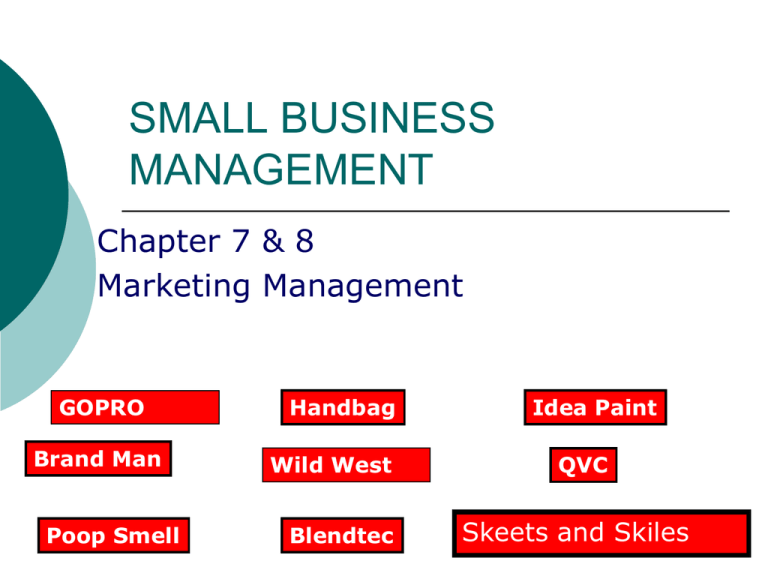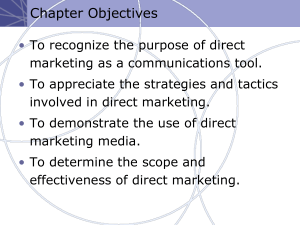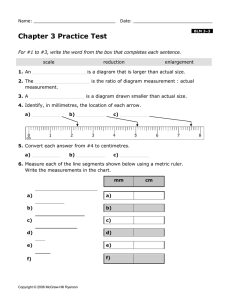
SMALL BUSINESS
MANAGEMENT
Chapter 7 & 8
Marketing Management
GOPRO
Brand Man
Poop Smell
Handbag
Wild West
Blendtec
Idea Paint
QVC
Skeets and Skiles
Skeets and Skiles
How do we make a Buck?
Margin * Volume
(Selling price – cost) * Volume
How could these companies increase their
making a buck?
Breadman
Java Nook
Cottage Cheesecake
Earth Buddy
Bright Lights
The Role of Marketing Management in the
Small Business
Defining the target customer,
characteristics and wants and needs
Understanding the environmentals that
affect operations
Developing the product and/or service
Developing the channels of distribution
Setting price levels of the product
and/service
Promoting the product and/or service to
those influential in its purchase
Market Segmentation and Target
Marketing: Beyond the Basics
Market segmentation is simply defined as
breaking a marketplace down into
categories of buyers who share similar
characteristics
Target marketing is the process of looking
at what segment your company can most
profitably serve and then modifying your
product, price, placement and promotion to
deliver value versus your competition to
your chosen targets
Steps in Preparing the Marketing
Plan
Keys to Successful Market
Segmentation
1.
2.
3.
4.
5.
Meaningful
Mutually exclusive
Measurable
Substantial
Actionable
Copyright © 2014 McGraw-Hill Ryerson.
All rights reserved.
Steps in Moving Your
Segmentation Beyond the Basics
1. Decide what general market or industry
you wish to pursue
2. Divide the market into smaller groups
based on the characteristics of the customer
and buying situation. These may include the
following:
Demographic
Geographic
Brand Man
Target Customer
Consumer Market
Organization market
Export market
How do find out info about the
target customer> Market research
Steps in Moving Your Segmentation
Beyond the Basics (cont.)
Psychographic (e.g., personality and
lifestyle)
Motivation (e.g., rational, emotional)
Influencers (e.g., anyone else influencing
decision, importance or opinion leaders)
Price sensitivity
Desired benefit (e.g., product features)
Usage (e.g., rate of use)
Copyright © 2014 McGraw-Hill Ryerson.
All rights reserved.
Steps in Moving Your Segmentation
Beyond the Basics (cont.)
Buying conditions (e.g., familiarity of
product and willingness to buy)
Awareness of buying intentions (e.g.,
familiarity of product and willingness to
buy)
3. Make sure the segments are
meaningful, mutually exclusive,
measurable, substantial, and actionable
Copyright © 2014 McGraw-Hill Ryerson.
All rights reserved.
Steps in Preparing the Marketing
Plan
Steps in Moving Your Segmentation
Beyond the Basics (cont.)
4. Select a segment(s) to target
5. Develop a marketing plan that integrates
product, price, placement, and promotion
Copyright © 2014 McGraw-Hill Ryerson.
All rights reserved.
Steps in Preparing the Marketing
Plan
Customer Relationship Marketing
Database Information System
Database Marketing For The Small Business
Copyright © 2014 McGraw-Hill Ryerson.
All rights reserved.
Steps in Preparing the Marketing
Plan
Applications of Customer Relationship
Management And Databases
Nurture The Customer
Grow The Customer
Retain The Customer
Win Customers Back
Copyright © 2014 McGraw-Hill Ryerson.
All rights reserved.
Influences External to the Market
The Economy
Competition
Legal Restrictions
Social and Cultural Environment
Technology
Influences External to the Market (Fig 8-6)
Management of External Influences
The Influences
Economy, competition, legal,
socio/cultural, technology
The Possible Characteristics
System to Monitor
Possible Internal Adjustments
The Marketing Plan
The Marketing Mix
The actual short-term marketing decisions in
the marketing plan will consist of four
important marketing variables: Product or
service, pricing, distribution or place, and
promotion
GOPRO
Copyright © 2014 McGraw-Hill Ryerson.
All rights reserved.
Developing the Product or Service
Develop Product or Service Policies
Decide How the Product Will Be
Manufactured
Understand the Product Life Cycle
Determine Factors That May Accelerate
Product or Service Adoption
Wild West
Developing the Product or Service (cont)
Determine Factors that Accelerate
Adoption
relative advantage
complexity
divisibility
communicability of results
Vulcan Alberta -- Wild West
How the Consumer Classifies the
Product and/or Service
convenience products
shopping products
appliances, stereos, cameras
specialty products
Staple vs impulse
Mercedes
Unsought
Funeral plots
How the Organizations Classifies the
Product and/or Service
Production Goods
Raw Materials:
Component parts: becomes part of the
physical product
Process materials: not readily identifiable part
of the production of other products
Support Goods
Major Equipment:
Accessory Equipment: Type writers and tools
Consumable Supplies: IE Paper, pencils or oils
Business to Business services: Financial, legal
marketing research etc.
Developing the Distribution System (Fig 8-9)
Channel Options
Manufacturer to Consumer (Short-Direct)
Manufacturer to Wholesaler to retailer to
consumer (Long-Indirect)
Channel length
Channel Intensity
Breadman
Java Nook
Cottage Cheesecake
Earth Buddy
Bright Lights
Spitz
Idea Paint
Setting the Price for the Good and/or Service
Cost-Based Pricing
Demand-Based Pricing
elasticity
Competition-Based Pricing
Movement & Shift of demand curve
QVC
Promotion
Types of Promotion
Advertising
types, advantages, disadvantages,
suitability, costs
Sales Promotion
Public Relations
Personal Selling
Poop Smell
Handbag
Types of Promotion
Non-traditional Promotional Methods
Non-traditional promotional methods can be defined as
pursuing traditional business goals of sales and profits
through non-conventional means
Guerrilla Marketing
Public Relations
Public relations is defined as generating positive awareness
of your company
Internet Marketing
Company Web Pages
Search Engine Optimization (SEO)
Copyright © 2014 McGraw-Hill Ryerson.
All rights reserved.
Types of Promotion
Internet Marketing (cont.)
Pay-Per Click Advertising (PPC)
Online Newsletter
Direct Email to Customers
Banner Advertisements
Affiliate Programs
Online Classified Advertising Sites
Online Auction Sites
Gamification
Online Games
Copyright © 2014 McGraw-Hill Ryerson.
All rights reserved.
Types of Promotion
Internet Marketing (cont.)
Podcasts
Webinars
Social Networking
Social networking sites are online communities
where people can meet new people, talk to current
friends, and build their networks
Facebook
Linkedin
Foursquare
Twitter/Tumblr/Online Blogs
Copyright © 2014 McGraw-Hill Ryerson.
All rights reserved.
Types of Promotion
Internet Marketing (cont.)
Photo Sharing Sites (Pinterest, Instagram,
and Flickr)
Video Sharing Sites (YouTube, Vine)
Mobile Marketing
Blendtec
Apps or Application
Text/SMS Messages
QR Codes
Proximity/Location-Based Marketing
Copyright © 2014 McGraw-Hill Ryerson.
All rights reserved.
Steps in a Promotional Campaign
1. Set Promotional Objectives (NUMBERS)
2. Determine the Promotional Target
3. Understand the Target’s Needs and
Perceptions of the Product/Service
4. Develop the Relevant Theme
5. Determine the Method or Media to Use
Steps in a Promotional Campaign (cont)
6. Develop a Specific Promotional
Message
7. Set the Promotional Budget
8. Implement the Program
9. Evaluate the Effectiveness of the
Promotion




